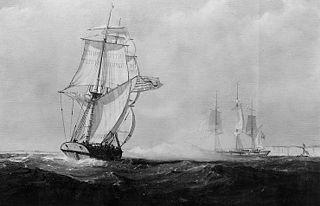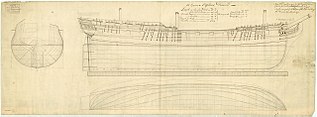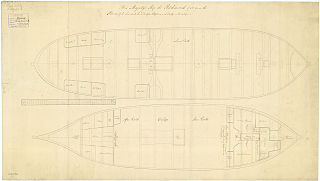
The second USS Revenge was a cutter in the Continental Navy and later a privateer.

The fourth HMS Diamond was a modified Lowestoffe-class fifth-rate frigate ordered in 1770, launched in 1774, but did not begin service until 1776. Diamond served off the eastern North American coast and shared in the capture at least one brig during the American Revolutionary War. The frigate was paid off in 1779, but returned to service the same year after being coppered. Diamond sailed to the West Indies in 1780, was paid off a final time in 1783 and sold in 1784.
HMS Bedford was a Royal Navy 74-gun third rate. This ship of the line was launched on 27 October 1775 at Woolwich.

HMS Lark was a 32-gun Richmond-class frigate fifth-rate frigate of the Royal Navy. She was launched in 1762 and destroyed in Narragansett Bay in 1778, during the American Revolutionary War.

HMS Yarmouth was a 64-gun third rate ship of the line of the Royal Navy, designed and built by Joseph Allin the younger at Deptford Dockyard. She was previously ordered to the dimensions specified in the 1741 proposals for modifications to the 1719 Establishment, but the Admiralty had very quickly concluded that these were too small, and as an experiment in 1742 authorised an addition of 6ft to the planned length, and Yarmouth was re-ordered to the enlarged design in June 1742. She was built at Deptford, where the Admiralty felt they could best observe the effectiveness of the added size, and launched on 8 March 1745.
HMS Antigua was a 14-gun sloop that served in the British Royal Navy from 1779 to 1792. In contemporary records she is sometimes referred to as "His Majesty's armed brig Antigua".

HMS Ambuscade was a 32-gun fifth-rate frigate of the Royal Navy, built in the Grove Street shipyard of Adams & Barnard at Depford in 1773. The French captured her in 1798 but the British recaptured her in 1803. She was broken up in 1810.

HMS Carysfort was a 28-gun Coventry-class sixth-rate frigate of the Royal Navy. She served during the American War of Independence, the French Revolutionary and the Napoleonic Wars in a career that spanned over forty years.

HMS Siren was a 28-gun Enterprise-class sixth-rate frigate of the Royal Navy. Siren was first commissioned in August 1775 under the command of Captain Tobias Furneaux, her only commanding officer.

HMS Mermaid was a Mermaid-class sixth-rate frigate of the Royal Navy. She was first commissioned in April 1761 under Captain George Watson and built in Blaydes Yard in Kingston-Upon-Hull.

HMS Solebay was a Mermaid-class sixth-rate frigate of the Royal Navy which saw active service between 1766 and 1782, during the latter part of the Seven Years' War and throughout the American Revolutionary War. After a successful career in which she captured seven enemy vessels, she was wrecked ashore on the Caribbean Island of Nevis.

HMS Juno was a 32-gun Richmond-class fifth-rate frigate of the Royal Navy. She was launched in 1757 and served throughout the American Revolutionary War until scuttled in 1778 to avoid capture. On 9 July, 1777 she captured Betsy in Boston Bay. On 9 January, 1778 she captured French snow David 3-4 miles off the north east tip of Block Island. She engaged USS Providence during Providence's escape from Providence, Rhode Island 30 April 1778.

HMS Richmond was the name ship of the six-vessel, 32-gun Richmond-class fifth-rate frigates of the Royal Navy. She was launched in 1757 and served throughout the American Revolutionary War. She and HMS Emerald captured French brig Alexandrine in Chesapeake Bay off the mouth of the Rappahannock River 3 January, 1778. She captured 1 prise off Cape Charles in February, 1778. She was captured by the French 74-gun Bourgogne and the frigate Aigrette captured her on 11 September 1781 in the Chesapeake. She then served as Richemont under Lieutenant Mortemart.

HMS Milford was a 28-gun Coventry-class sixth-rate frigate of the Royal Navy. She was built at Milford by Richard Chitty and launched in 1759. She was sold for breaking at Woolwich on 17 May 1785.
HMS Galatea was a 20-gun Sphinx-class sixth-rate post-ship of the Royal Navy. She was designed by John Williams and built by Adam Hayes in Deptford Dockyard being launched on 21 March 1776. She served during the American War of Independence.

HMS Phoenix was a 44-gun fifth-rate ship of the Royal Navy. She was launched in 1759 and sunk in 1780 and saw service during the American War of Independence.

Experiment was a 50-gun ship of the line of the British Royal Navy. Captured by Sagittaire during the War of American Independence, she was recommissioned in the French Navy, where she served into the 1800s.
HMS Glory was a 32-gun fifth-rate Niger-class frigate of the Royal Navy, and was the second Royal Navy ship to bear this name.













